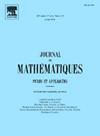Graph-to-local limit for the nonlocal interaction equation
IF 2.3
1区 数学
Q1 MATHEMATICS
引用次数: 0
Abstract
We study a class of nonlocal partial differential equations presenting a tensor-mobility, in space, obtained asymptotically from nonlocal dynamics on localizing infinite graphs. Our strategy relies on the variational structure of both equations, being a Riemannian and Finslerian gradient flow, respectively. More precisely, we prove that weak solutions of the nonlocal interaction equation on graphs converge to weak solutions of the aforementioned class of nonlocal interaction equation with a tensor-mobility in the Euclidean space. This highlights an interesting property of the graph, being a potential space-discretization for the equation under study.
Résumé. Nous étudions une classe d'équations aux dérivées partielles non locales présentant une mobilité tensorielle, dans l'espace, obtenue asymptotiquement à partir de dynamiques non locales sur des graphes infinis localisants. Notre stratégie repose sur la structure variationnelle des deux équations, qui sont respectivement un flot de gradients riemannien et finslérien. Plus précisément, nous prouvons que les solutions faibles de l'équation d'interaction non locale sur les graphes convergent vers des solutions faibles de la classe mentionnée d'équations d'interaction non locales avec une mobilité tensorielle dans l'espace euclidien. Cela met en évidence une propriété intéressante du graphe, à savoir une discrétisation spatiale potentielle pour l'équation étudiée.
非局部相互作用方程的图到局部极限
研究了一类具有空间渐近的张量迁移性的非局部偏微分方程,它是由局域无限图上的非局部动力学得到的。我们的策略依赖于两个方程的变分结构,分别是黎曼和芬斯勒梯度流。更确切地说,我们证明了图上的非局部相互作用方程的弱解收敛于上述一类具有张量迁移率的非局部相互作用方程在欧几里德空间中的弱解。这突出了图的一个有趣的性质,即所研究的方程的潜在空间离散化。现有的 ()和其他的 ()和其他的()和其他的。在结构变化的基础上,采用了两个不同的结构变量,分别对两个不同的结构变量进行了分析。加上pracassimement, nous提供了一个简单的解决方案,可以解决所有的麻烦事麻烦事麻烦事麻烦事麻烦事麻烦事麻烦事麻烦事麻烦事麻烦事麻烦事麻烦事麻烦事麻烦事麻烦事麻烦事麻烦事麻烦事麻烦事。a . en en samitence one propriant samitere du grape, e. savoir one discratement, e. spatiale potentielle pour l' samitere, e. samitere。
本文章由计算机程序翻译,如有差异,请以英文原文为准。
求助全文
约1分钟内获得全文
求助全文
来源期刊
CiteScore
4.30
自引率
0.00%
发文量
84
审稿时长
6 months
期刊介绍:
Published from 1836 by the leading French mathematicians, the Journal des Mathématiques Pures et Appliquées is the second oldest international mathematical journal in the world. It was founded by Joseph Liouville and published continuously by leading French Mathematicians - among the latest: Jean Leray, Jacques-Louis Lions, Paul Malliavin and presently Pierre-Louis Lions.

 求助内容:
求助内容: 应助结果提醒方式:
应助结果提醒方式:


